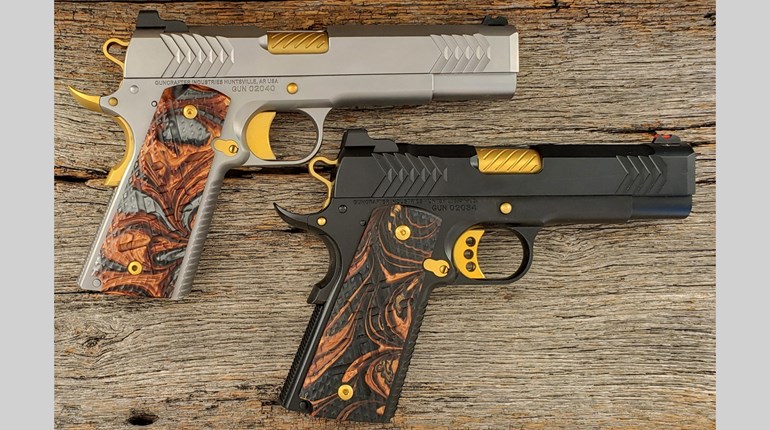
If you're not already, by the end of this year you'll likely be sick of hearing about 1911s and might look forward to an article about a Glock. Don't get me wrong, a 1911 is my handgun of choice, but it's not just about the handgun. The .45-caliber cartridge Browning designed to go with the 1911 had a great deal to do with the pistol's stardom.
The short version of the story is the U.S. military was underwhelmed by the .38-caliber revolvers that replaced its Colt Single Action Army chambered for the .45 Colt cartridge. Influenced by field experience and the Thompson-LaGarde tests of 1904, the military decided its service handgun should once again be a .45 caliber. Browning was hard at work on a semi-automatic service pistol for the military and settled on a .45-caliber cartridge capable of launching a 200-grain bullet at a muzzle velocity of 900 fps. Army Ordnance wanted a heavier bullet like the one used by its trusty old revolvers. This resulted in a .45 ACP load pushing a 230-grain bullet to 810 fps.
Now, 100 years later, there are .45 ACP loads available in factory ammunition for just about any application for which the cartridge can be conceived. CCI even offers a shotshell load suitable for snakes and vermin at close range. It is without question the most effective semi-auto shotshell I've ever tested. Extreme Shock in Clintwood, VA, offers a 125-grain frangible bullet that flies at 1,200 fps called the Air Freedom Round. It's designed for use inside aircraft, as it allegedly won't penetrate a plane's fuselage, and it creates wickedly large—albeit shallow—wound cavities in tissue. However, this bullet comes apart on hard surfaces.
If you want to hunt medium to large game with the .45 ACP, you're obviously limited by its effective range, but DoubleTap Ammunition offers a 255-grain, hard-cast Keith-style bullet, which will leave a 5-inch barrel at around 875 fps. Buffalo Bore also offers a 255-grain hard-cast, flat-nose bullet at an even faster 925 fps. Both loads should be capable of penetrating just about any beast you might stumble upon. Four feet of ordnance gelatin will not stop either bullet. If you think multiple bad guys might assault you in single file, one of these loads should let the air out of all of them simultaneously.
The .45 ACP loads that span the 130 grains between these extremes are where you'll find the most suitable defensive, practice and competition loads. They utilize precision-engineered bullets to deliver superior accuracy, controlled expansion and moderate to deep penetration—some even after passing through robust intermediate barriers. Most are loaded to a standard pressure of 21,000 psi, but +P loads generating 23,000 psi are available.
While I don't handload a wide variety of .45 ACP ammunition, I do have a few favorite loads. The one I use most is a 200-grain lead semi-wadcutter (LSWC) atop 4.5 grains of Hodgdon Clays. It pushes this bullet to Browning's conceptual 900 fps. Generally I'm not real picky about which 200-grain LSWC bullet I use—the ones I can get for the best price are perfectly fine. I've used this same load for years, and it has performed great in every 1911 I've shot. For a jacketed version of this load, I like Sierra's 200-grain FPJ bullet atop 8.7 grains of Accurate No. 5 powder, which generates nearly the same velocity.
A wicked defensive load for the .45 ACP is the Nosler 185-grain JHP load from DoubleTap. This bullet screams out of a 5-inch 1911 at over 1,100 fps and will expand almost as wide as a quarter in 10-percent ordnance gelatin. It also has stiff recoil—especially out of lightweight or compact 1911s. Using 8.0 grains of Hodgdon Longshot, I cut the velocity back to around 950 fps for a controllable and very accurate target load. This is not a great defensive load because the 185-grain Nosler JHP will not expand at this reduced velocity.
The most popular .45 ACP load has always been the original 230-grain FMJ. Some trust it exclusively for competition, self-defense and plinking. This load does have the distinction of serving successfully in every major American military conflict from World War I to the present. It's not sexy, it's not fast and it's not cutting edge, but you'd probably be more successful at professional Sasquatch hunting than arguing with its supporters. This "hardball" round will punch through 3 feet or more of gelatin. To duplicate most factory 230-grain FMJ loads, 7.6 grains of Ramshot True Blue does the trick. Moreover, all of these handloads will make major power factor for competition.
This is indeed the year of what is arguably the most trusted fighting pistol ever created. However, without the .45 ACP cartridge, the famous 1911 might have evaporated into oblivion. Because of our NATO affiliation, the 9 mm has eclipsed the .45 ACP in worldwide popularity. But, it will never be inexorably linked to the most famous fighting handgun of all time.
With the wide variety of .45 ACP ammunition on the market, handloading for this cartridge is more of a labor of love, an effort to find the pinnacle of perfection or just a way of being able to shoot a lot for as little money as possible. I guess I do it for all three reasons.


































